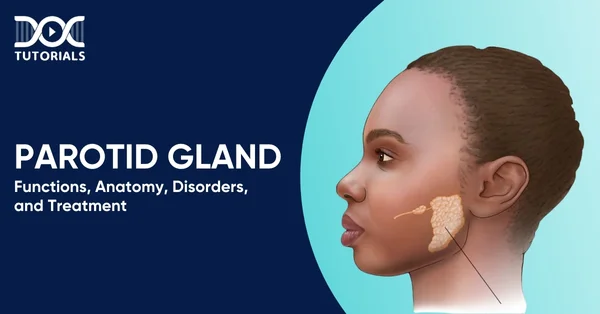Parotid Gland | Functions, Anatomy, Disorders, and Treatment

The parotid gland is one of the 3 types of salivary glands in the human body. Although its function is sometimes overlooked, it plays a significant role in maintaining a person’s health. The parotid gland plays a crucial role in maintaining human health in several ways, including breaking down food particles to facilitate digestion and preventing the mouth from drying out.
Sometimes, however, this gland doesn’t function as well as it could due to specific issues. These problems can be fixed if they are found early enough. Understanding the parotid gland is crucial for the NEET PG test if you are a medical student preparing for it.
For more information about this gland, its functions, potential problems, and other details, continue reading.
What is the Parotid Gland?
The parotid gland is a salivary gland that sits in front of the ears and behind the lower jaw. Like the sublingual and submandibular glands, it produces saliva to aid in chewing, digestion, and keeping the mouth moist.
You can treat infections or oedema in the parotid glands with antibiotics, warm compresses, or massage. Depending on the case, treatment for parotid gland tumours may include surgery to remove the gland, chemotherapy, or radiation therapy.
What Does the Parotid Gland Do?
The parotid gland’s primary function is to produce thin, watery saliva and release amylase, a protein that aids in breaking down starch. The parotid gland makes saliva, which has a few essential jobs:
- Lessens the number of harmful bacteria in the mouth
- It helps keep the mouth moist.
- Helps with digestion
- Keep cavities from forming on teeth
- The parotid salivary glands make roughly 10% of the saliva in the mouth and 25% more when you eat.
What Does the Parotid Gland Look Like?
The parotid glands are two glands located just in front of the ears, extending from the masseter muscle to the rear of the lower jawbone (mandible). The parotid glands are located in a specific part of the neck known as the submandibular or digastric triangle.
The facial nerve divides each gland into two parts:
- Superficial Lobe
The superficial lobe is located on the outside of the facial nerve and covers the lateral aspect of the masseter muscle.
- Deep Lobe
On the other hand, the deep lobe is on the inside of the facial nerve, between the mastoid process of the temporal bone and the ramus of the jaw. This deep component extends into the prestyloid compartment of the parapharyngeal space, a deep area located near the throat.
To understand the gland’s function and how it relates to neighbouring structures, you need to know how this arrangement works.
What are the Common Disorders of the Parotid Gland?
Some health problems that might cause the parotid gland to hurt and enlarge are:
Sialolithiasis
Sialolithiasis is a common cause. It occurs when stones form in the ducts of the parotid gland and block them. This blockage causes uncomfortable swelling that worsens during meals, when saliva flow increases.
Sialadenitis
It is an infection of the parotid gland that can occur when something gets stuck or when bacteria or viruses, including Staphylococcus bacteria or the mumps virus, enter. Infections usually make you swell, hurt, and have a fever.
Parotid Gland Tumour
It is another probable cause of oedema. These tumours can grow in either the superficial or deep lobe of the gland, making the jaw or face appear larger. Most parotid tumours are not carcinogenic, but some are.
Parotid Gland Cancer
It is relatively uncommon, accounting for only 6% to 8% of all head and neck malignancies. But if you have cancer, it’s essential to get treatment quickly and as soon as possible to stop the cancer cells from spreading to neighbouring lymph nodes and other tissues.
What are the Treatment Options for Parotid Gland Disorder?
The treatment for parotid gland diseases depends on the underlying cause. Here are the major ways to treat different disorders:
Stones and Blockages
Small stones in the ducts of the parotid gland may pass on their own, but if they continue to block the ducts, help is usually needed. Shockwave therapy (lithotripsy), surgery to remove the stones, or probing to empty the duct are all options for treatment.
Tumours
Most of the time, surgery is used to remove parotid gland tumours. If the tumour is cancerous, doctors may suggest other treatments like chemotherapy or radiotherapy, depending on how big it is, how far it has spread, and what stage it is in.
Sjogren’s Syndrome
To treat this autoimmune disease, it is necessary to alleviate the symptoms. Patients should drink plenty of water, chew sugar-free gum to make saliva, stay away from alcohol, and sometimes use drugs to produce more saliva or keep inflammation under control.
Bacterial Infections
Antibiotics are used to treat bacterial infections of the parotid gland and reduce swelling.
Viral Infection: Mumps
There is no specific antiviral medication that is effective for mumps. The sickness typically goes away in one to two weeks. Rest, drink plenty of water, and take over-the-counter pain relievers like ibuprofen or paracetamol to help alleviate symptoms. To prevent the infection from spreading to other people, you need to isolate yourself.
FAQs about the Parotid Gland
- How can you tell if the parotid gland is blocked?
Most disorders with the parotid gland generate the same symptoms, like swelling in the face or jaw, pain that gets worse after eating, and often a fever.
- What makes the parotid glands swell up?
Parotitis occurs when the parotid gland swells up. This can happen because of a viral illness (like mumps or the flu) or a bacterial infection. For viral infections, rest and fluids are enough. For bacterial infections, antibiotics are needed.
- How can you tell if your parotid gland is healthy?
A physical examination for pain or swelling is the first step in determining what is wrong with the parotid gland. For further assessment, doctors may request a needle biopsy or imaging tests, such as an MRI (magnetic resonance imaging), ultrasound, or CT (computed tomography) scan.
- How to keep the parotid gland healthy?
To keep your parotid glands healthy, drink enough water, chew sugar-free gum or candy, refrain from smoking, and limit your intake of caffeine and alcohol. Saliva replacements might assist, and these actions can minimise your risk of having difficulties.
- How do you treat a swollen parotid gland?
Sour candy can help your mouth produce more saliva and may help clear out minor blockages in the parotid gland. If the swelling persists, consult your doctor for a proper diagnosis and treatment.
Conclusion
The parotid gland is essential for oral health and should be covered in the NEET PG course. DocTutorials can help you with this, and our study materials, video lectures, and assignments are all designed to meet the needs of students who want to learn.
Sign up for our NEET PG course right now and do well on the NEET PG test!
Latest Blogs
-

NEET SS Exam 2024: Analysis, Key Dates, Counselling
The NEET SS 2024 exam kicked off on March 29, 2025. Over two days and two slots, candidates across 13…
-

NEET PG Registration 2025: An Essential Guide For Exam Prep
The NEET PG registration, which is conducted online, is a crucial step in the exam process. Filling out the NEET…
-

NEET PG Syllabus 2026: A Must-Have Complete Guide for Exam Success
The NEET PG Syllabus acts as one of the foundation stones for aspiring postgraduate medical students like you who are…




